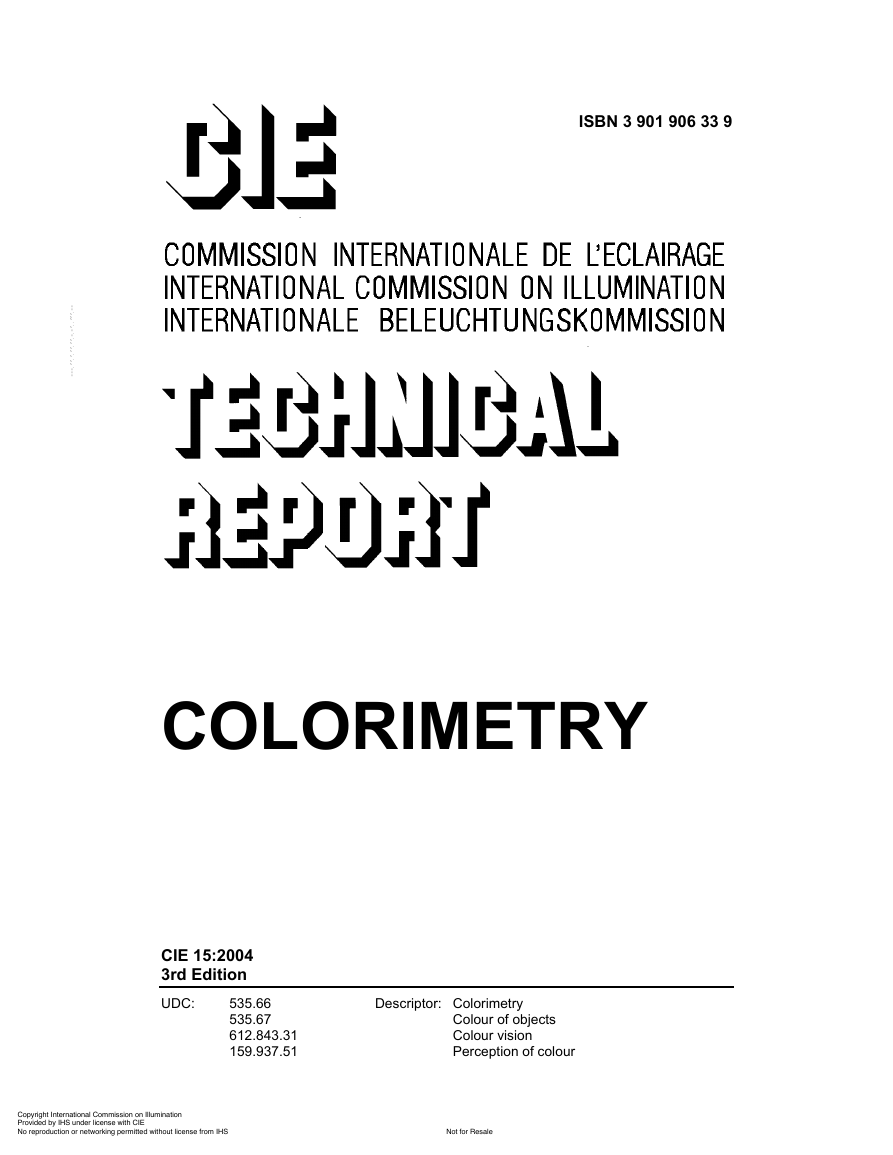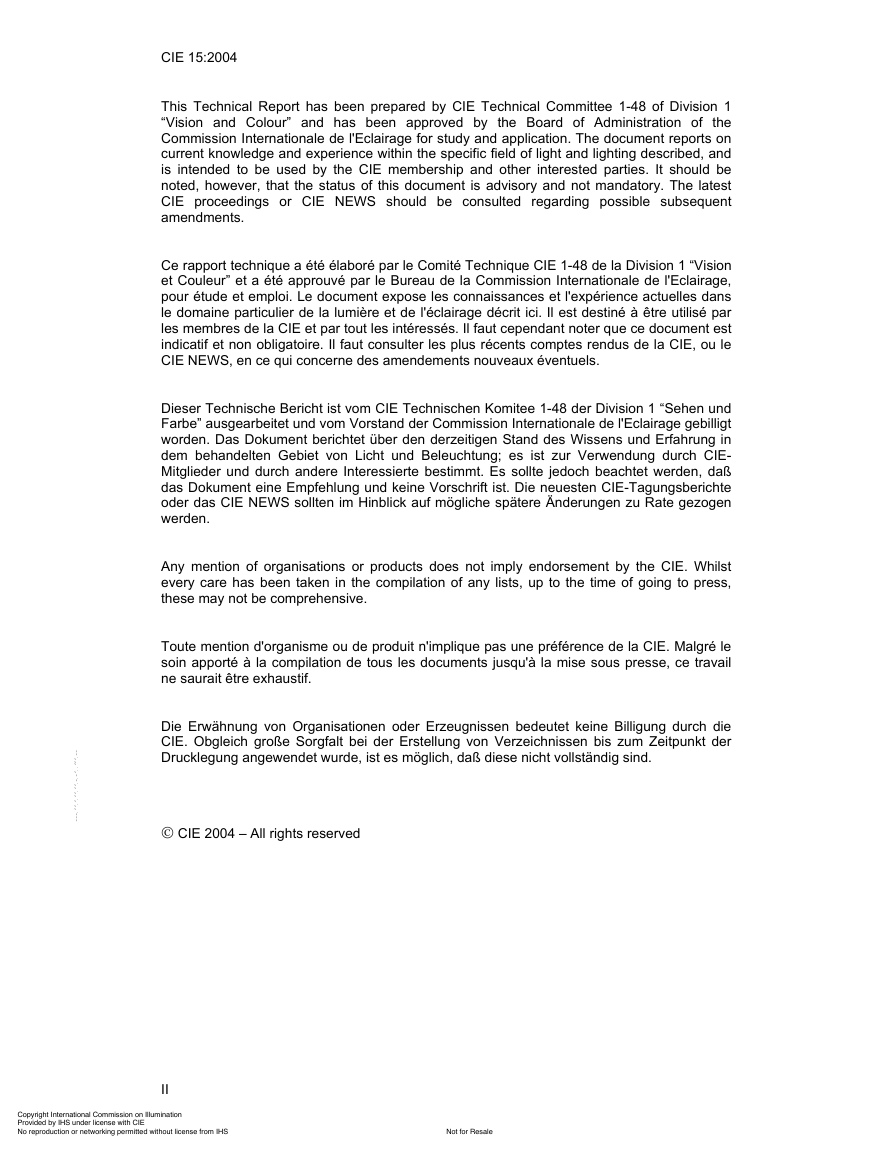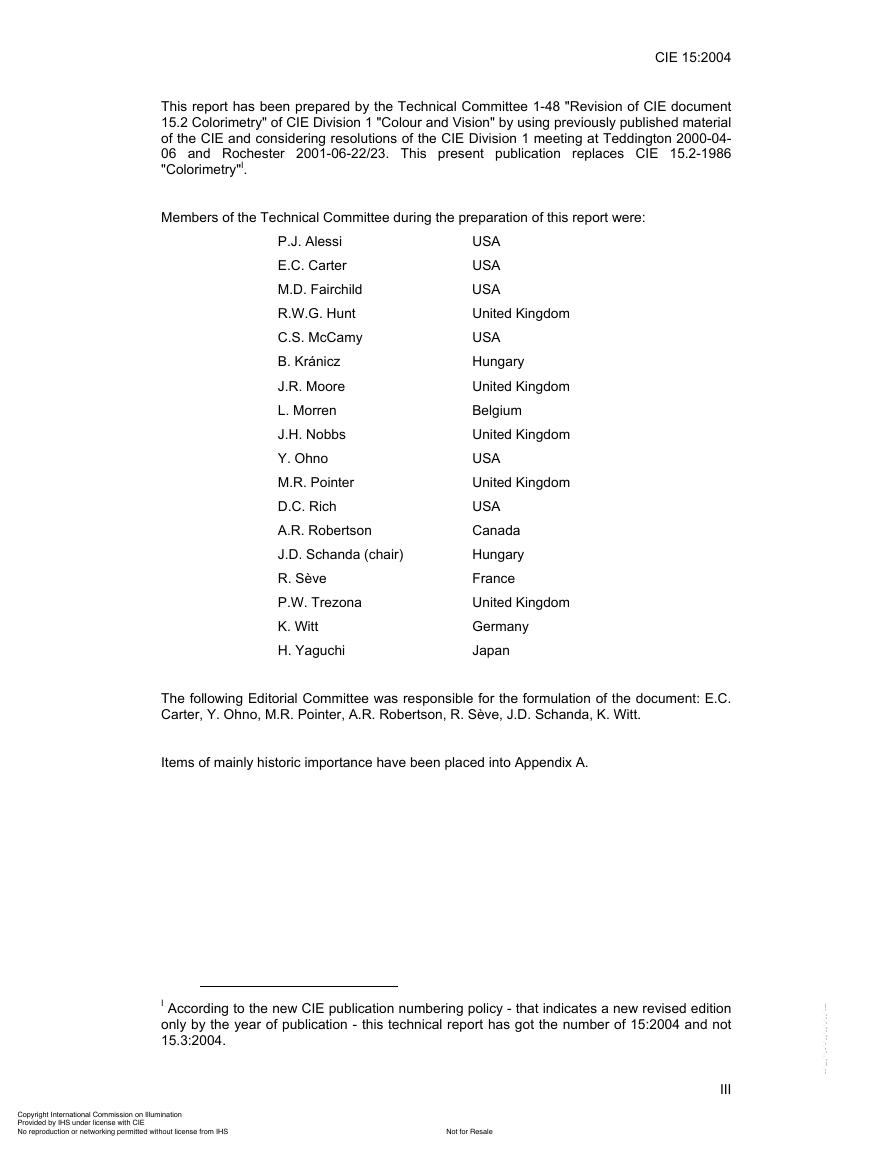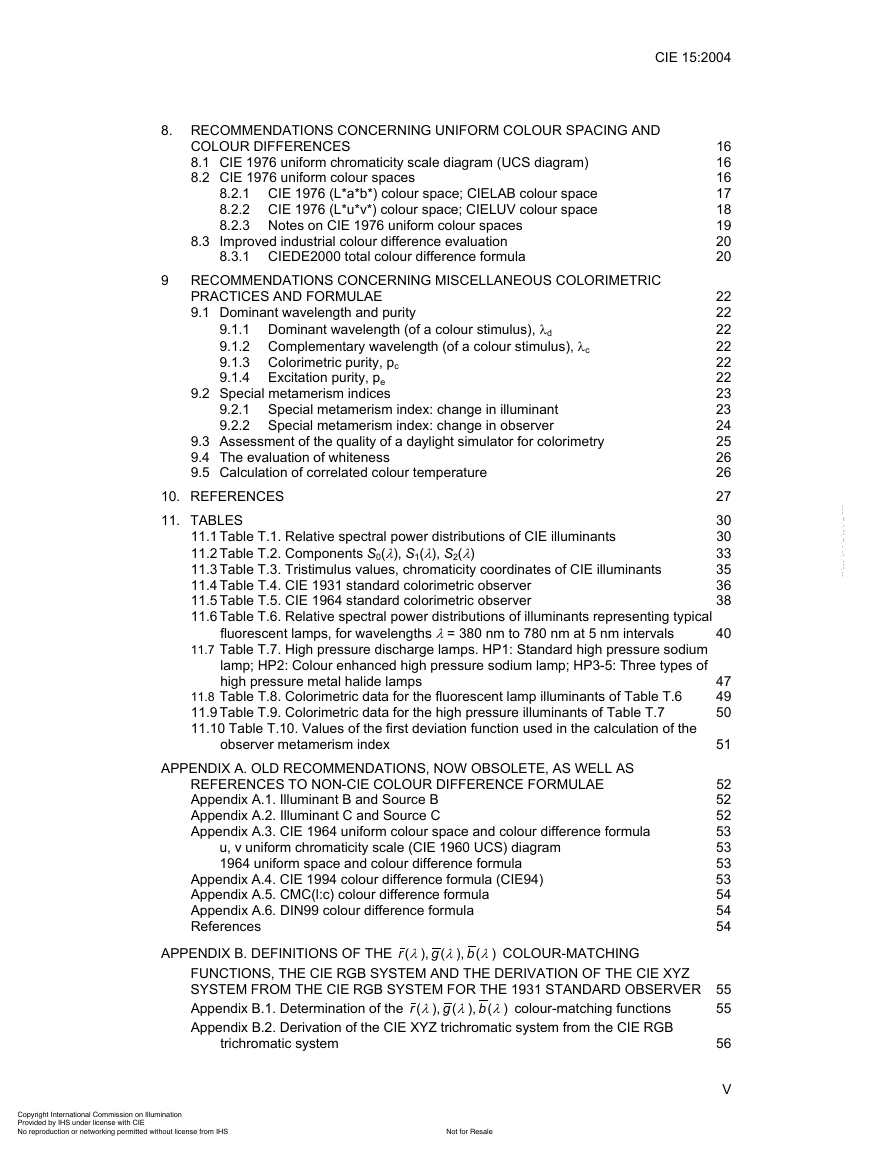ISBN 3 901 906 33 9
COLORIMETRY
CIE 15:2004
3rd Edition
UDC:
535.66
535.67
612.843.31
159.937.51
Descriptor: Colorimetry
Colour of objects
Colour vision
Perception of colour
Copyright International Commission on Illumination Provided by IHS under license with CIENot for ResaleNo reproduction or networking permitted without license from IHS--`,,,``,-`-`,,`,,`,`,,`---�
THE INTERNATIONAL COMMISSION ON ILLUMINATION
The International Commission on Illumination (CIE) is an organisation devoted to international co-operation and exchange of
information among its member countries on all matters relating to the art and science of lighting. Its membership consists of
the National Committees in 38 countries and one geographical area and of 4 associate members.
The objectives of the CIE are :
1.
To provide an international forum for the discussion of all matters relating to the science, technology and art in the
fields of light and lighting and for the interchange of information in these fields between countries.
To develop basic standards and procedures of metrology in the fields of light and lighting.
To provide guidance in the application of principles and procedures in the development of international and national
standards in the fields of light and lighting.
To prepare and publish standards, reports and other publications concerned with all matters relating to the science,
technology and art in the fields of light and lighting.
To maintain liaison and technical interaction with other international organisations concerned with matters related to
the science, technology, standardisation and art in the fields of light and lighting.
The work of the CIE is carried on by seven Divisions each with about 20 Technical Committees. This work covers subjects
ranging from fundamental matters to all types of lighting applications. The standards and technical reports developed by
these international Divisions of the CIE are accepted throughout the world.
A plenary session is held every four years at which the work of the Divisions and Technical Committees is reviewed,
reported and plans are made for the future. The CIE is recognised as the authority on all aspects of light and lighting. As
such it occupies an important position among international organisations.
2.
3.
4.
5.
2.
3.
4.
5.
LA COMMISSION INTERNATIONALE DE L'ECLAIRAGE
La Commission Internationale de l'Eclairage (CIE) est une organisation qui se donne pour but la coopération internationale
et l'échange d'informations entre les Pays membres sur toutes les questions relatives à l'art et à la science de l'éclairage.
Elle est composée de Comités Nationaux représentant 38 pays plus un territoire géographique, et de 4 membres associés.
Les objectifs de la CIE sont :
1.
De constituer un centre d'étude international pour toute matière relevant de la science, de la technologie et de l'art de
la lumière et de l'éclairage et pour l'échange entre pays d'informations dans ces domaines.
D'élaborer des normes et des méthodes de base pour la métrologie dans les domaines de la lumière et de l'éclairage.
De donner des directives pour l'application des principes et des méthodes d'élaboration de normes internationales et
nationales dans les domaines de la lumière et de l'éclairage.
De préparer et publier des normes, rapports et autres textes, concernant toutes matières relatives à la science, la
technologie et l'art dans les domaines de la lumière et de l'éclairage.
De maintenir une liaison et une collaboration technique avec les autres organisations internationales concernées par
des sujets relatifs à la science, la technologie, la normalisation et l'art dans les domaines de la lumière et de
l'éclairage.
Les travaux de la CIE sont effectués par 7 Divisions, ayant chacune environ 20 Comités Techniques. Les sujets d'études
s'étendent des questions fondamentales, à tous les types d'applications de l'éclairage. Les normes et les rapports
techniques élaborés par ces Divisions Internationales de la CIE sont reconnus dans le monde entier.
Tous les quatre ans, une Session plénière passe en revue le travail des Divisions et des Comités Techniques, en fait
rapport et établit les projets de travaux pour l'avenir. La CIE est reconnue comme la plus haute autorité en ce qui concerne
tous les aspects de la lumière et de l'éclairage. Elle occupe comme telle une position importante parmi les organisations
internationales.
DIE INTERNATIONALE BELEUCHTUNGSKOMMISSION
Die Internationale Beleuchtungskommission (CIE) ist eine Organisation, die sich der internationalen Zusammenarbeit und
dem Austausch von Informationen zwischen ihren Mitgliedsländern bezüglich der Kunst und Wissenschaft der Lichttechnik
widmet. Die Mitgliedschaft besteht aus den Nationalen Komitees in 38 Ländern und einem geographischen Gebiet und aus
4 assoziierten Mitgliedern.
Die Ziele der CIE sind :
1.
Ein internationaler Mittelpunkt für Diskussionen aller Fragen auf dem Gebiet der Wissenschaft, Technik und Kunst der
Lichttechnik und für den Informationsaustausch auf diesen Gebieten zwischen den einzelnen Ländern zu sein.
Grundnormen und Verfahren der Meßtechnik auf dem Gebiet der Lichttechnik zu entwickeln.
Richtlinien für die Anwendung von Prinzipien und Vorgängen in der Entwicklung internationaler und nationaler
Normen auf dem Gebiet der Lichttechnik zu erstellen.
Normen, Berichte und andere Publikationen zu erstellen und zu veröffentlichen, die alle Fragen auf dem Gebiet der
Wissenschaft, Technik und Kunst der Lichttechnik betreffen.
Liaison und technische Zusammenarbeit mit anderen internationalen Organisationen zu unterhalten, die mit Fragen
der Wissenschaft, Technik, Normung und Kunst auf dem Gebiet der Lichttechnik zu tun haben.
Die Arbeit der CIE wird in 7 Divisionen, jede mit etwa 20 Technischen Komitees, geleistet. Diese Arbeit betrifft Gebiete mit
grundlegendem Inhalt bis zu allen Arten der Lichtanwendung. Die Normen und Technischen Berichte, die von diesen
international zusammengesetzten Divisionen ausgearbeitet werden, sind von der ganzen Welt anerkannt.
Tagungen werden alle vier Jahre abgehalten, in der die Arbeiten der Divisionen überprüft und berichtet und neue Pläne für
die Zukunft ausgearbeitet werden. Die CIE wird als höchste Autorität für alle Aspekte des Lichtes und der Beleuchtung
angesehen. Auf diese Weise unterhält sie eine bedeutende Stellung unter den internationalen Organisationen.
Published by the
2.
3.
4.
5.
COMMISSION INTERNATIONALE DE L'ECLAIRAGE
CIE Central Bureau
Kegelgasse 27, A-1030 Vienna, AUSTRIA
Tel: +43(1)714 31 87 0, Fax: +43(1)714 31 87 18
e-mail: ciecb@ping.at
WWW: http://www.cie.co.at/
© CIE 2004 – All rights reserved
Copyright International Commission on Illumination Provided by IHS under license with CIENot for ResaleNo reproduction or networking permitted without license from IHS--`,,,``,-`-`,,`,,`,`,,`---�
ISBN 3 901 906 33 9
COLORIMETRY
CIE 15:2004
3rd Edition
UDC:
535.66
535.67
612.843.31
159.937.51
Descriptor: Colorimetry
Colour of objects
Colour vision
Perception of colour
Copyright International Commission on Illumination Provided by IHS under license with CIENot for ResaleNo reproduction or networking permitted without license from IHS--`,,,``,-`-`,,`,,`,`,,`---�
CIE 15:2004
This Technical Report has been prepared by CIE Technical Committee 1-48 of Division 1
“Vision and Colour” and has been approved by the Board of Administration of the
Commission Internationale de l'Eclairage for study and application. The document reports on
current knowledge and experience within the specific field of light and lighting described, and
is intended to be used by the CIE membership and other interested parties. It should be
noted, however, that the status of this document is advisory and not mandatory. The latest
CIE proceedings or CIE NEWS should be consulted regarding possible subsequent
amendments.
Ce rapport technique a été élaboré par le Comité Technique CIE 1-48 de la Division 1 “Vision
et Couleur” et a été approuvé par le Bureau de la Commission Internationale de l'Eclairage,
pour étude et emploi. Le document expose les connaissances et l'expérience actuelles dans
le domaine particulier de la lumière et de l'éclairage décrit ici. Il est destiné à être utilisé par
les membres de la CIE et par tout les intéressés. Il faut cependant noter que ce document est
indicatif et non obligatoire. Il faut consulter les plus récents comptes rendus de la CIE, ou le
CIE NEWS, en ce qui concerne des amendements nouveaux éventuels.
Dieser Technische Bericht ist vom CIE Technischen Komitee 1-48 der Division 1 “Sehen und
Farbe” ausgearbeitet und vom Vorstand der Commission Internationale de l'Eclairage gebilligt
worden. Das Dokument berichtet über den derzeitigen Stand des Wissens und Erfahrung in
dem behandelten Gebiet von Licht und Beleuchtung; es ist zur Verwendung durch CIE-
Mitglieder und durch andere Interessierte bestimmt. Es sollte jedoch beachtet werden, daß
das Dokument eine Empfehlung und keine Vorschrift ist. Die neuesten CIE-Tagungsberichte
oder das CIE NEWS sollten im Hinblick auf mögliche spätere Änderungen zu Rate gezogen
werden.
Any mention of organisations or products does not imply endorsement by the CIE. Whilst
every care has been taken in the compilation of any lists, up to the time of going to press,
these may not be comprehensive.
Toute mention d'organisme ou de produit n'implique pas une préférence de la CIE. Malgré le
soin apporté à la compilation de tous les documents jusqu'à la mise sous presse, ce travail
ne saurait être exhaustif.
Die Erwähnung von Organisationen oder Erzeugnissen bedeutet keine Billigung durch die
CIE. Obgleich große Sorgfalt bei der Erstellung von Verzeichnissen bis zum Zeitpunkt der
Drucklegung angewendet wurde, ist es möglich, daß diese nicht vollständig sind.
© CIE 2004 – All rights reserved
II
Copyright International Commission on Illumination Provided by IHS under license with CIENot for ResaleNo reproduction or networking permitted without license from IHS--`,,,``,-`-`,,`,,`,`,,`---�
CIE 15:2004
This report has been prepared by the Technical Committee 1-48 "Revision of CIE document
15.2 Colorimetry" of CIE Division 1 "Colour and Vision" by using previously published material
of the CIE and considering resolutions of the CIE Division 1 meeting at Teddington 2000-04-
06 and Rochester 2001-06-22/23. This present publication replaces CIE 15.2-1986
"Colorimetry"I.
Members of the Technical Committee during the preparation of this report were:
P.J. Alessi
E.C. Carter
M.D. Fairchild
R.W.G. Hunt
C.S. McCamy
B. Kránicz
J.R. Moore
L. Morren
J.H. Nobbs
Y. Ohno
M.R. Pointer
D.C. Rich
A.R. Robertson
J.D. Schanda (chair)
R. Sève
P.W. Trezona
K. Witt
H. Yaguchi
USA
USA
USA
United Kingdom
USA
Hungary
United Kingdom
Belgium
United Kingdom
USA
United Kingdom
USA
Canada
Hungary
France
United Kingdom
Germany
Japan
The following Editorial Committee was responsible for the formulation of the document: E.C.
Carter, Y. Ohno, M.R. Pointer, A.R. Robertson, R. Sève, J.D. Schanda, K. Witt.
Items of mainly historic importance have been placed into Appendix A.
I According to the new CIE publication numbering policy - that indicates a new revised edition
only by the year of publication - this technical report has got the number of 15:2004 and not
15.3:2004.
III
Copyright International Commission on Illumination Provided by IHS under license with CIENot for ResaleNo reproduction or networking permitted without license from IHS--`,,,``,-`-`,,`,,`,`,,`---�
CIE 15:2004
TABLE OF CONTENTS
SUMMARY
RESUME
ZUSAMMENFASSUNG
1. SCOPE
2. PREFACE
3. RECOMMENDATIONS CONCERNING STANDARD PHYSICAL DATA OF
ILLUMINANTS AND SOURCES
3.1 Recommendations concerning standard physical data of illuminants
3.2 Artificial sources representative of illuminants
4. RECOMMENDATIONS CONCERNING STANDARD OF REFLECTANCE
5. RECOMMENDATIONS CONCERNING GEOMETRIC CONDITIONS FOR
5.2 Recommended geometry for reflection measurements
COLORIMETRY
5.1 Recommended nomenclature for directional irradiation
5.1.1 Forty-five degree directional geometry (45°x)
5.1.2 Forty-five degree annular geometry (45°a)
5.1.3 Zero degree directional geometry (0°)
5.1.4 Eight degree geometry (8°)
5.2.1 Diffuse: eight-degree geometry, specular component included (di:8°)
5.2.2 Diffuse: eight-degree geometry, specular component excluded (de:8°)
5.2.3 Eight degree: diffuse geometry, specular component included (8°:di)
5.2.4 Eight degree: diffuse geometry, specular component excluded (8°:de)
5.2.5 Diffuse / diffuse geometry (d:d)
5.2.6 Alternative diffuse geometry (d:0°)
5.2.7 Forty-five degree annular / normal geometry (45°a:0°)
5.2.8 Normal / forty-five degree annular geometry (0°:45°a)
5.2.9 Forty-five degree directional / normal geometry (45°x:0°)
5.2.10 Normal / forty-five degree directional geometry (0°:45°x)
5.3.1 Normal / normal geometry (0°:0°)
5.3.2 Diffuse / normal geometry, regular component included (di:0°)
5.3.3 Diffuse / normal geometry, regular component excluded (de:0°)
5.3.4 Normal / diffuse geometry, regular component included (0°:di)
5.3.5 Normal / diffuse geometry, regular component excluded (0°:de)
5.3.6 Diffuse / diffuse geometry (d:d)
5.3 Recommended geometry for transmission measurements
6. RECOMMENDATIONS CONCERNING STANDARD OBSERVER DATA
6.1 CIE 1931 standard colorimetric observer
6.2 CIE 1964 standard colorimetric observer
7. RECOMMENDATIONS CONCERNING THE CALCULATION OF TRISTIMULUS
VALUES AND CHROMATICITY COORDINATES
7.1 Calculation of tristimulus values
7.2 The use of abridged or truncated data
Illuminants and self-luminous objects
7.1.1 Secondary light sources (reflecting or transmitting objects)
7.1.2
7.2.1 Abridgement
7.2.2 Truncation
7.2.3 Weighting factors
7.2.4 Numerical procedures
7.2.5 Bandwidth of a spectrometer
7.3 Calculation of chromaticity coordinates
7.4 Equations representing relationships between colour stimuli
VII
VII
VII
1
1
2
2
5
5
5
6
6
6
6
7
7
7
7
7
7
7
7
7
8
8
8
8
8
9
9
9
9
9
9
9
10
12
12
12
13
13
13
14
14
15
15
15
16
IV
Copyright International Commission on Illumination Provided by IHS under license with CIENot for ResaleNo reproduction or networking permitted without license from IHS--`,,,``,-`-`,,`,,`,`,,`---�
CIE 15:2004
8. RECOMMENDATIONS CONCERNING UNIFORM COLOUR SPACING AND
COLOUR DIFFERENCES
8.1 CIE 1976 uniform chromaticity scale diagram (UCS diagram)
8.2 CIE 1976 uniform colour spaces
8.2.1 CIE 1976 (L*a*b*) colour space; CIELAB colour space
8.2.2 CIE 1976 (L*u*v*) colour space; CIELUV colour space
8.2.3 Notes on CIE 1976 uniform colour spaces
8.3.1 CIEDE2000 total colour difference formula
8.3 Improved industrial colour difference evaluation
16
16
16
17
18
19
20
20
9 RECOMMENDATIONS CONCERNING MISCELLANEOUS COLORIMETRIC
PRACTICES AND FORMULAE
9.1 Dominant wavelength and purity
9.1.1 Dominant wavelength (of a colour stimulus), λd
9.1.2 Complementary wavelength (of a colour stimulus), λc
9.1.3 Colorimetric purity, pc
9.1.4 Excitation purity, pe
9.2 Special metamerism indices
9.2.1 Special metamerism index: change in illuminant
9.2.2 Special metamerism index: change in observer
9.3 Assessment of the quality of a daylight simulator for colorimetry
9.4 The evaluation of whiteness
9.5 Calculation of correlated colour temperature
10. REFERENCES
11. TABLES
22
22
22
22
22
22
23
23
24
25
26
26
27
30
30
33
35
36
38
40
47
49
50
51
52
52
52
53
53
53
53
54
54
54
56
V
11.1 Table T.1. Relative spectral power distributions of CIE illuminants
11.2 Table T.2. Components S0(λ), S1(λ), S2(λ)
11.3 Table T.3. Tristimulus values, chromaticity coordinates of CIE illuminants
11.4 Table T.4. CIE 1931 standard colorimetric observer
11.5 Table T.5. CIE 1964 standard colorimetric observer
11.6 Table T.6. Relative spectral power distributions of illuminants representing typical
fluorescent lamps, for wavelengths λ = 380 nm to 780 nm at 5 nm intervals
11.7 Table T.7. High pressure discharge lamps. HP1: Standard high pressure sodium
lamp; HP2: Colour enhanced high pressure sodium lamp; HP3-5: Three types of
high pressure metal halide lamps
11.8 Table T.8. Colorimetric data for the fluorescent lamp illuminants of Table T.6
11.9 Table T.9. Colorimetric data for the high pressure illuminants of Table T.7
11.10 Table T.10. Values of the first deviation function used in the calculation of the
observer metamerism index
APPENDIX A. OLD RECOMMENDATIONS, NOW OBSOLETE, AS WELL AS
REFERENCES TO NON-CIE COLOUR DIFFERENCE FORMULAE
Appendix A.1. Illuminant B and Source B
Appendix A.2. Illuminant C and Source C
Appendix A.3. CIE 1964 uniform colour space and colour difference formula
u, v uniform chromaticity scale (CIE 1960 UCS) diagram
1964 uniform space and colour difference formula
Appendix A.4. CIE 1994 colour difference formula (CIE94)
Appendix A.5. CMC(l:c) colour difference formula
Appendix A.6. DIN99 colour difference formula
References
APPENDIX B. DEFINITIONS OF THE
r
(
)
λλλ
),
),
b
g
(
(
COLOUR-MATCHING
FUNCTIONS, THE CIE RGB SYSTEM AND THE DERIVATION OF THE CIE XYZ
SYSTEM FROM THE CIE RGB SYSTEM FOR THE 1931 STANDARD OBSERVER 55
55
Appendix B.1. Determination of the
colour-matching functions
Appendix B.2. Derivation of the CIE XYZ trichromatic system from the CIE RGB
(
)
λλλ
),
),
b
g
(
(
r
trichromatic system
Copyright International Commission on Illumination Provided by IHS under license with CIENot for ResaleNo reproduction or networking permitted without license from IHS--`,,,``,-`-`,,`,,`,`,,`---�
57
61
62
65
66
66
67
67
68
CIE 15:2004
Appendix B.3. Definition of the colour-matching functions in the CIE 1964 trichromatic
system
Reference
APPENDIX C. ALTERNATIVE METHOD TO DEFINE DAYLIGHT ILLUMINANTS -
METHOD OF CALCULATION, CORRECTED TABLES AND EQUATIONS (FOR
INFORMATION AND EVALUATION)
References
APPENDIX D. REVERSE TRANSFORMATION FROM VALUES L*, a*, b* TO
TRISTIMULUS VALUES X, Y, Z
Reference
APPENDIX E. INFORMATION ON THE USE OF PLANCK’S EQUATION FOR
STANDARD AIR
References
EXPLANATORY COMMENTS
VI
Copyright International Commission on Illumination Provided by IHS under license with CIENot for ResaleNo reproduction or networking permitted without license from IHS--`,,,``,-`-`,,`,,`,`,,`---�
















 2023年江西萍乡中考道德与法治真题及答案.doc
2023年江西萍乡中考道德与法治真题及答案.doc 2012年重庆南川中考生物真题及答案.doc
2012年重庆南川中考生物真题及答案.doc 2013年江西师范大学地理学综合及文艺理论基础考研真题.doc
2013年江西师范大学地理学综合及文艺理论基础考研真题.doc 2020年四川甘孜小升初语文真题及答案I卷.doc
2020年四川甘孜小升初语文真题及答案I卷.doc 2020年注册岩土工程师专业基础考试真题及答案.doc
2020年注册岩土工程师专业基础考试真题及答案.doc 2023-2024学年福建省厦门市九年级上学期数学月考试题及答案.doc
2023-2024学年福建省厦门市九年级上学期数学月考试题及答案.doc 2021-2022学年辽宁省沈阳市大东区九年级上学期语文期末试题及答案.doc
2021-2022学年辽宁省沈阳市大东区九年级上学期语文期末试题及答案.doc 2022-2023学年北京东城区初三第一学期物理期末试卷及答案.doc
2022-2023学年北京东城区初三第一学期物理期末试卷及答案.doc 2018上半年江西教师资格初中地理学科知识与教学能力真题及答案.doc
2018上半年江西教师资格初中地理学科知识与教学能力真题及答案.doc 2012年河北国家公务员申论考试真题及答案-省级.doc
2012年河北国家公务员申论考试真题及答案-省级.doc 2020-2021学年江苏省扬州市江都区邵樊片九年级上学期数学第一次质量检测试题及答案.doc
2020-2021学年江苏省扬州市江都区邵樊片九年级上学期数学第一次质量检测试题及答案.doc 2022下半年黑龙江教师资格证中学综合素质真题及答案.doc
2022下半年黑龙江教师资格证中学综合素质真题及答案.doc